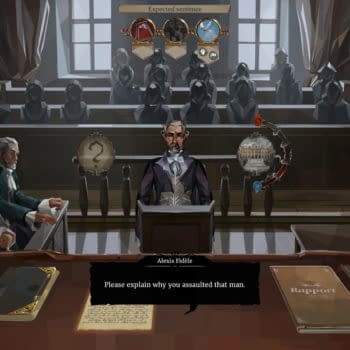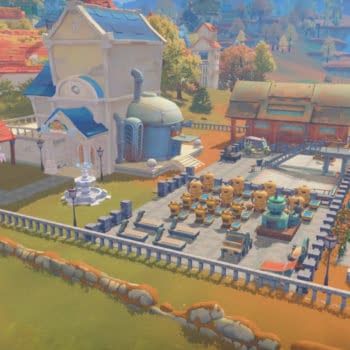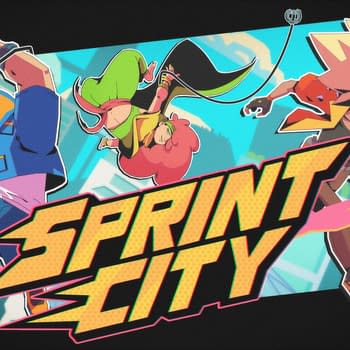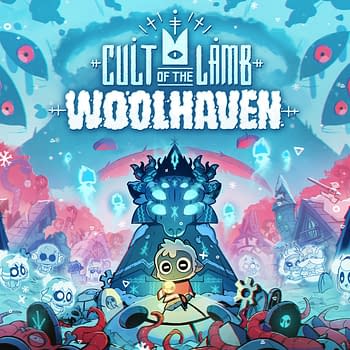Posted in: Games, Review, Video Games | Tagged: Alastair Siddons, alicia vikander, crystal dynamics, Geneva Robetson-Dworet, roar uthaug, Square Enix, Warner Bros
A Gamer's Review of Tomb Raider: Far Too Much a Retelling Than an Adaptation
While Tomb Raider is something of a retelling of the 2013 Tomb Raider reboot game by Crystal Dynamics, it deviates in a lot of key ways. Beware: gentle spoilers ahead, but I will try to keep things relatively vague.
While the film's artistic credits have already been discussed by my colleagues Kaitlyn Booth and Bill Watters, I figured we'd tackle this one from strictly a gamer's point of view. Before going into the screening of the film, I made a bit of a checklist for myself on things I'd expected the movie to hit. Now, these weren't target goals of things I'd like to see, or even things they should do, but rather baseline expectations. And the movie hit just about all of them.
I can say, as well, that film is much less heavy on the Lara Croft Torture Porn scenarios I was expecting to watch. The 2013 reboot of the game series did many things to revamp our image of who Lara Croft is and restart the Tomb Raider story from the beginning, but it fell into a trap many action franchises tend to when their protagonist is a woman. We watch a whole lot of unnecessary torture, often of the sexualized variety, as a way to provide "character development." The film manages to limp its way over this bar by providing perhaps at most a collective 15 minutes of Lara Croft getting beaten to hell by an "evil" island and its murderous Trinity inhabitants.
Less torture porn is always a great thing, because let's be real: sexualized violence involving women in films is never really about character development. It's about titillating the audience by watching a woman go through literal hell just for the joy of it. Granted, we've set a pretty low bar with Tomb Raider, but there are still films that wouldn't manage to limp over it. Red Sparrow, for instance. Of course, there's also the lazy motivation factor to consider. It's much easier for a writer to hurt a female character to give her a reason for her later actions than to give her any kind of complex character motivation. Of course, we often see violence against women used as motivation for male characters, which is why sexual violence against female protagonists is mostly used for the sake of "entertainment" or "shock value."
In this case, the film is much less guilty of needlessly torturing Lara Croft than the game was. Most of the violence Lara suffers in the film is at the hands of the unforgiving island of Yamatai, and serves as an action survival sequence. Now, it does get to the point of being frankly ridiculous after a bit, a sentiment which is echoed by Lara in the film asking "really?" In fact, Lara only has one major scuffle with a male character in the movie, and while it is a bit sexualized — they wrestle in the mud until she drowns him in a puddle — the majority of Tomb Raider is free of using violence as a means of entertainment or character motivation. Which is a rather solid win considering my initial expectations.
That aside, just about all of my predictions managed to hit. We got one, and really only one, puzzle to solve in the titular tomb. Most of the plot was motivated by Lara's daddy issues, and things got slightly mystical while still keeping to a somewhat grounded explanation for extraordinary circumstances.
The lack of puzzle solving and proper tomb raiding is perhaps the saddest bit of this movie from a gamer's perspective. One of the hallmarks of the gaming franchise is its puzzles. The game series is all about avoiding the lethal traps inside centuries old burial chambers, after all. And in the movie adaptation, we get one whole color puzzle. It's a bit of a disappointment, as some of the puzzles in the game are frankly fascinating to watch, but it does make sense considering the film was not designed for gamers.
Yeah, that's right. This is a video game adaptation movie designed to work as a film, not as a series of inside jokes and references that'll keep an audience of hardcore gamers entertained. And it's mostly better for that. Not having a ton of puzzles or stealth action sequences works very well with the film's core point — Lara Croft is not yet the Tomb Raider we've come to know and love. This is her coming-of-age story. And while the game had that same bent, ultimately, it all comes across better on screen than it ever did in-game.
While there are a few glaring plot holes in the film, mostly revolving around the logistics of the evil island Yamatai and the life of Death Queen Himiko, they are mostly pretty easy to overlook. Nothing you'll go home tearing your hair apart for, unless you just cannot help but refuse to suspend even a single shred of disbelief for the film. Of course, some of those plot holes were well explained in the game, but that's what happens when you have 30 hours to tell a story, and then try to condense it into a solid two-hour movie. In fact, the only one not even slightly explained is (not a spoiler because we've seen it in the trailer) villain Mathais Vogel's insistence that he is alone on Yamatai, despite being surrounded by mercenaries and slaves. But ultimately I chalked that one up to an attempt to make Vogel more insane and creepy than he is already.
Perhaps the most burning question I had walking out of Tomb Raider was if the series was going to have more of a mystical bent again or if it would keep trying to stick to the more skeptical, science side of things. A large piece of the film's plot is the curse of Death Queen Himiko. Richard Croft was fully willing to believe in the curse, even going so far as to try and convince his daughter of its veracity. Meanwhile Vogel and Lara have a much more skeptical, almost cavalier, attitude toward the curse. The film is ultimately forced to make a choice, but it has opened the possibility. And that could prove to be an interesting way to get the films to differentiate much more from Square Enix and Crystal Dynamics' series of games.
After all, the reboot Tomb Raider games have been much more on the science side of things. At least so far.
In fact, the film would have been much better off if it were willing to stray further from the source material. As someone who played the game, there wasn't much suspense at all because the plot mirrored that of the game in so many ways. I'd have liked to see a few more changes — see the film crew take possession of the story as their own rather than work as translators. There are glimpses in Tomb Raider of the film it could have been, had they taken it just one or two steps farther — which just makes it all the more disappointing when they don't.
From a strictly gamer's perspective, Tomb Raider is a watchable film. Alicia Vikander does a fantastic job as Lara, while director Roar Uthaug and writers Geneva Robertson-Dworet and Alastair Siddons have done a decent job of making a film out of a lengthy platformer. That's not an easy task — just ask the Prince of Persia: The Sands of Time (2010) team. Sure, this film is nothing to write home about. There are points where you see the movie it could have been, had the team strayed a bit farther from the source material, but it is an enjoyable film nonetheless. It's just a retelling of the game, rather than an adaptation. Some people might enjoy that, but I like not being horribly bored, myself.






![[REVIEW] "Gang Beasts" is Zany Party Madness](https://mlpnk72yciwc.i.optimole.com/cqhiHLc.IIZS~2ef73/w:350/h:350/q:75/rt:fill/g:ce/https://bleedingcool.com/wp-content/uploads/2019/09/gang-beasts-7-350x350.jpg)




![[REVIEW] "Divinity: Original Sin II" Definitive Edition is Almost Perfect](https://mlpnk72yciwc.i.optimole.com/cqhiHLc.IIZS~2ef73/w:350/h:350/q:75/rt:fill/g:ce/https://bleedingcool.com/wp-content/uploads/2018/08/Divinity-Original-Sin-2-Definitive-Edition-art-350x350.jpg)





